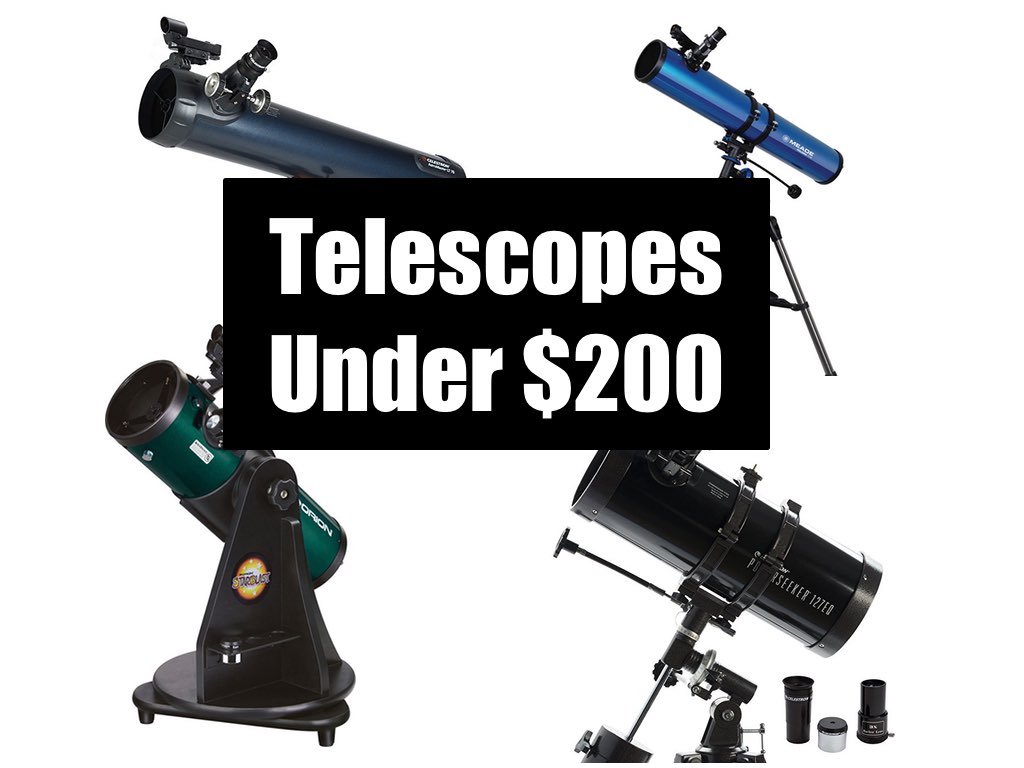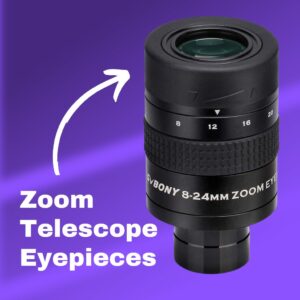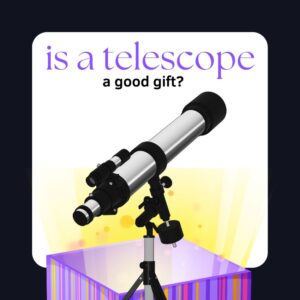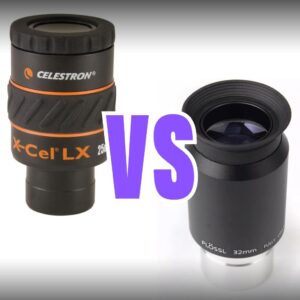This site contains affiliate links to products. I may receive a commission for purchases made through these links.
If you are on a tight budget and want to buy a telescope, you can have difficulty deciding which one is the best choice for your money. You certainly don’t want to buy any crappy one, but you don’t have to worry because $200 is a perfect budget for the first telescope.
If you plan to buy it for a kid, you can go with a price even lower, but $200 will buy you decent scope. I’m going to list here only one type of telescope, which is called a reflector. The other well-known type is a reflector.
The main difference between reflectors and refractors is that the reflector uses mirrors to produce the image, and the refractor is using lenses. Reflecting telescopes are much cheaper because manufacturing big mirrors is easier than creating a lens. Therefore you will get more telescope for your money on a low budget. So, let’s hop on our list of the 4 best telescopes under $200.
1. Celestron AstroMaster LT 76AZ – Entry Level

Click here to see the price on Amazon
This telescope was the first one I owned, and I still have it. It has a 76mm aperture with a 700mm focal length. 76mm aperture size is the minimum for reflectors, in my opinion. It collects enough light to provide good views of the night sky. Because this telescope is entry-level, don’t expect too much from it.
But on the other hand, it will not disappoint you; I guarantee that. Seeing the moon for the first time with this telescope was unforgettable. You can see the Moon closely to notice the surface details and even see smaller craters.
Because it has 700mm focal length, it can also provide sufficient magnification for planets. Particularly the Jupiter and the Saturn. It is possible to see some details on Jupiter, and in good seeing conditions, also the famous Saturn rings. If you are under dark skies away from the city, you will also enjoy some of the brightest deep-sky objects.
The telescope is on an altazimuth mount which is better quality than similar mounts by other brands. Celestron did an excellent job here. It has steel tube legs that are providing good stability and panhandle for comfortable control of the telescope. It is shipped with two eyepieces. One is 20mm which will provide 35x magnification, and the second, 10mm, is for 70x magnification. The red dot finder is easy to use and is permanently mounted on the telescope.
Verdict
The Celestron AstroMaster LT 76AZ telescope is easy to assemble (under 10min) and easy to transport so you can take it anywhere with you to enjoy the dark skies. This telescope has its limits, but it is a great choice for beginners, kids included. Overall it is good for kids and anyone who wants to see something more than with binoculars.
You may also like: The Best Telescope For Kids To Spark an Interest in Astronomy
2. Orion StarBlast 4.5 Astro Reflector Telescope – Small Miracle
This telescope really is a blast as his name indicates. You may think that it is a toy when you look at it, but it’s not. Small and compact with a 114mm aperture on a Dobsonian mount. It has a bigger aperture than the first telescope in my list, so it will collect much more light to give even better views. The image is crisp and bright.
You will be amazed at what this little scope can do. His focal length is 450mm, making this telescope the f/4, a very fast telescope. It will give you a bright and big field of view. With this said, it is better for deep-sky objects than the Celestron LT76.
The eyepieces that are included are Kelner type 17mm and 6mm. So, you can expect two magnifications of 26x and 75x. The highest useful magnification for this telescope is 228x. It means that you can combine the 2x Barlow lens with a 6mm eyepiece for 150x magnification or a 3x Barlow lens with a 6mm eyepiece to get almost the maximum 225x magnification. But for such magnification, you need right-seeing conditions, and I would stick to 150x max anyway to have a good image.
Maybe you have never seen a telescope mounted on this type of mount. It is called the Dobsonian mount. The advantage of it is that it’s simple to assemble and it is quite small. It doesn’t take up too much space, and you can have the telescope on the table when you are outside. This mount is also very intuitive, and moving the telescope across the sky is a blast.
Verdict
To sum it up, I will say that this telescope is perfect for everyone. I know that even some professional astronomers have this scope at home. It’s easy to use, has a sufficient aperture, and has a small compact design. You won’t regret anything if you buy this telescope. It will come basically assembled, so you can use it minutes after unboxing. The bonus included in the box is the Starry Night software that will help you learn the sky on your computer.
You may also like: Are GoTo Telescopes Worth It? (My Real Experience)
3. Meade Instruments Polaris 114 EQ – The Planet Hunter
When you look at this telescope, it starts to look more professional. It is made by one of the top telescope brands- Meade. You would not believe that you can have a telescope like this for under $200! But you can, and if you are interested in planets and closeups of the Moon, this is a no-brainer.
It doesn’t excel for deep sky objects, but because it has a focal length of 1000mm, you can expect high magnifications that are a must for planetary viewing. The 114mm is more than enough for planets and the Moon because you don’t need to collect a lot of light. These objects are very bright. Planets are tiny in the sky, so you will benefit from the higher magnification.
It comes with three eyepieces and 2x Barlow lenses, so you can enjoy a variety of magnifications. You will get 26mm, 9mm, and 6.3mm eyepieces. Therefore, this will get you 38x, 111x, and 158x magnification. With the Barlow lens added, these magnifications will double. But remember that this telescope’s highest useful magnification is 228x. You won’t be able to use the 6.3mm eyepiece with the Barlow lens. However, the 6.3mm eyepiece alone will give you enough magnification and a crystal clear image.
The Meade Instruments Polaris 114 is on the equatorial mount. This type of mount is more complicated for beginners than an altazimuth mount. Although, you will learn how to use it fast.
Before every use of this telescope, you’ll need some extra time because you have to align the equatorial mount. It is a simple process, and you find the instructions in the manual. In short, you have to align the mount with the North and point the mount to the Polaris based on your latitude.
The advantage of the equatorial mount is that after you align it and point to the object you want to see, you only need to move the telescope on one axis. With an altazimuth mount, you always have to adjust the telescope in two axes while tracking the moving object in the sky.
Verdict
The Meade Instruments Polaris 114EQ telescope is not good for kids. It is suitable for adults or teenagers because the equatorial mount needs some time to master.
4. Celestron PowerSeeker 127EQ – The Best Telescope Under $200
This telescope is a bestseller on Amazon. And there is no doubt why because for under $200, it is a decent scope. It has the biggest aperture of all telescopes mentioned in this list, so it can collect a lot of light. 127mm at this price is really good. Many other telescopes with this aperture cost much more.
But more interestingly, it has a 1000mm focal length which can confuse most people. When you take a look at the Celestron PowerSeeker 127EQ, it has a very short tube of 500mm. So how can it be 1000mm focal length?
The secret is the Bird-Jones optical design. You may know that if you put the 2x Barlow lens with the eyepiece into the focuser, it will double the magnification of the eyepiece. What it actually does is that it is doubling the focal length of the telescope as well.
So, telescopes with bird jones design use a built-in 2x Barlow lens in the focuser to double the telescope’s focal length. The result is a shorter tube with a longer focal length. Most people argue that it is not ideal, but it works very well for portability purposes. It is easier to manipulate and travel with the 500mm tube rather than 1000mm.
Overall, we have a pretty big scope in a small package under $200. As I said, the 127mm aperture is decent for such a cheap scope, and we already know the advantage of the long focal length from the above Meade Instruments Polaris 114 EQ telescope with the same focal length. It’s perfect for planets and moon craters and also deep-sky objects.
The PowerSeeker comes with two eyepieces and 3x Barlow lenses. Here is the big negative I want to talk about. The eyepieces are 20mm and 4mm. They are very low-quality instruments. This might be why people are sometimes unhappy with the view through this scope. The problem is not the telescope but the eyepieces.
If I were the owner, I would throw the eyepieces into the trash right after unboxing. I highly recommend upgrading the eyepieces if you want to get the maximum from this scope.
You can read my Telescope Eyepiece Guide and buy a set of new, better-quality eyepieces for under $30. Also, I would not use the 3x Barlow lens because there is already one built in, and the more optical elements you use in the design, the lower quality image you get. Maybe buy some well-made 2x Barlow, and you will enjoy it more.
The mount is the German equatorial mount which is sturdy enough to carry a scope of this size. The legs are aluminum; however, I would prefer metal tube legs used by Celestron in low-budget scopes. You will also need to learn how to use the equatorial mount, but it should be an easy routine after a few nights.
Read also: Celestron powerseeker 127eq review (Before purchasing)
Verdict
Despite my criticism of the eyepieces included in the package, it is the best telescope you can buy under $200. You will learn a lot about using an equatorial mount and finding objects in the sky. It is a well-built telescope for beginners and an all-rounder because of its portability. You will enjoy it in your backyard or on a camping trip.
You may also like: Which Telescope Should I Buy? (Master Guide)
Conclusion
And we are at the end of my list of 4 best telescopes under $200.
I hope this guide will help you decide on buying one because astronomy is a fantastic hobby. Kids, and of course adults too, can learn a lot about space when having a telescope. It is more fun and interesting than seeing the Moon and planets with the naked eye.
You just have to choose based on your budget and requirements. I assure you that if you pick any of the telescopes on my list, you won’t make a wrong decision.
You may also like:








